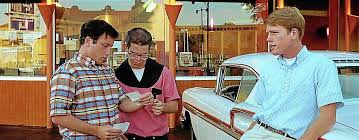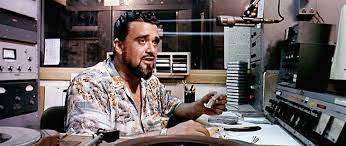“American Graffiti” was a culture-shifting blockbuster when it came out, a modestly-budgeted movie with a mostly-no-name cast that spawned a 1950s-early-’60s nostalgia boom that swam against the tide that gave birth to disco and punk.
Its warmth, innocence and fun, celebrating “car culture” in the middle of an Arab Oil Embargo, gave us “Happy Days” and “Laverne & Shirley” on TV, movies from “The Buddy Holly Story” to “La Bamba” and oldies radio stations that endured well into the ’90s.
But looking at it anew, 50 years after it launched the career of George Lucas, passing over its impact on the culture, you can’t help but be struck by how beautiful it is — the glossy images, indelible, quick-sketch archetypal characters, the visual and aural grandeur of it all.
“American Graffiti” is an American Epic.
It’s about the allure of leaving for a bigger life vs. the pull of the comforts and security of home, the celebration of youth culture and nostalgia for its rituals, an eagerness to “grow up” battling the ease of a life of arrested development, curiosity and naivete contrasted with the first insights of worldly wisdom.
Director and co-writer Lucas plainly felt bittersweet, conflicted about it all, looking back on the early ’60s a mere decade after he lived through them. His film became his “Great Gatsby,” his statement on his generation, and looking back, it’s clear that as popular as his later works became, this was his masterpiece.
Lucas was recreating his rural, overwhelmingly white Modesto, California youth, serving up a sort of “Andy Griffith” past where the farm-town’s Latin populace is represented by a lone character, and the tiny number of Black residents didn’t register.
But race and a shift in the culture worked its way in, through the music and by this admission from annoying tween Carol (Mackenzie Phillips) about her favorite DJ.
“I just LOVE listening to the Wolfman! My mom won’t let me at home, because he’s a Negro.”
The four threads of the totally masculine story are firstly, the Great Romance. Ron Howard is Steve, college-bound and clumsily trying to extract himself from his steady girlfriend. Laurie (Cindy Williams) is the only girl to wear his #62 letterman’s sweater.
“Where were you in ’62?” was the movie’s poster tag-line. And Steve’s big George-Bailey-in-“It’s-a-Wonderful-Life” decision is whether he has the guts to hurt someone he loves. Howard is wonderful as the exasperated, conflicted and responsible center of the movie. Cindy Williams is here to break his and our hearts.
You Can’t Go Home Again if you Never Leave is the thread about Curt. Richard Dreyfuss is Curt, Laurie’s brother and just as college-bound as Steve. But even though Curt has no real ties holding him there, he’s conflicted about going to college way out East. He will spend this “last night” sampling the world he might be leaving behind, tempted by the mysterious blonde in the white T-Bird (Suzanne Somers), buffeted by all the people urging him to “LEAVE.”
“We’re finally getting outta this turkey town,” Steve pleads. Besides, you don’t “wanna end up like John.”
That would be John Milner (Paul Le Mat), the Big Fish in a Small Town icon story thread. He’s an auto mechanic, and thanks to his yellow Little Deuce Coupe, the king of the illegal drag racing subculture. Like Wooderson, the “Dazed and Confused” character he inspired, Milner never left town, still acts like a juvenile and cruises every Friday night, looking for high school girls.
In Western terms, Milner’s the fastest gun. There’s always somebody new gunning for the legend. This night, that would be hotrodded ’55 Chevy cowboy Bob Falfa, played by future superstar Harrison Ford.
Curt? In a town of hot-rods and every V-8 under the sun, Curt drives a tiny Citroen 2CV. He’s plainly too hip for this ‘burg.
And the final thread is a Princess and the Frog story. Toad (Charles Martin Smith) is the runty mascot of them all, liked by everyone, respected by few. He figures his ticket out of that pigeon-hole isn’t leaving town. It’s Steve’s generous act of leaving Toad his ’58 Chevy Impala, fuzzy dice and all, to drive and take care of while he’s in college. Toad can reinvent himself in a town that thinks it knows him.
As we’ve seen him tumble off his Vespa pulling into Mel’s Drive-in, we know he’s got the steepest hill to climb. A lot of lies and misadventures trying to impress Deb (Candy Clark) lay ahead of him on this long, late-summer night.
As the music of the era — oldies from the ’50s, pre-Beatlemania/British Invasion pop and rock of the early ’60s — weaves in and out of the soundtrack, everybody in this narrative meets, flees or embraces his or her destiny.
The Dennis Lynton Clark production design of this picture is era-defining, and the 35mm Techniscope photography — the film had two directors of photography, with Lucas pitching in on some shots and Haskell Wexler “consulting” on the shooting — has a sheen that few digital shoots today could match.
But if you’re looking for the “Star Wars” saga to come in this film, you have to see beyond Harrison Ford and use your ears to do that. The seamless sound design (Walter Murch & Co.) uses music as the soundtrack of these lives. It is diegetic here, sounds that emanate from car radios — with every car radio tuned in to The Wolfman Jack Show — or a diner jukebox, with Flash Cadillac and the Continental Kids recreating the hits of the day live at the Freshman Hop at the local high school.
A song introduces a shift in scene or a new sequence, heard in full, deep, stereophonic sound. Then we’re edited into the interior of this VW Beetle, that Chevy, Edsel, Buick or whatever, with the Wolfman pranking phone callers and promising that tonight “We’re gon’rock’n roll ourselves to DEATH.”
The genius of this film is its sense of dropping in on one night of lives being lived. School restroom primping rituals, eagerness to get your hands on “the hard stuff,” the liberation of having a ride for the evening, the security of having someone you want to ride around with, it’s all become cliches now. But when Lucas came at it, it was fresh.
“American Graffiti” is brimming with movement — the swirl of the high school hop, the whirl of motion at the drive-in, the cars “doing the loop.” Cruising, flirting, mooning, and peeling out as a mating ritual isn’t limited to America, but it was invented and perfected here.
My favorite bits about it haven’t changed over the years. I laugh at the hilarious intimidation and then initiation of Curt into The Pharoahs, led by Bo Hopkins, every time it turns up. The famous Richard Dreyfuss laugh was introduced to the world in these scenes. How he kept a straight face among these goofy goons is a marvel.
And Curt’s fateful meeting with Wolfman Jack is quiet, touching and just a tad thrilling. He’s a kid stumbling into a creature of myth from the pre-Internet days when media figures could seem larger than life because who knew who this dude was, what he looked like or where he even broadcast from? Mr. “Ha’MERCY, baby” embodies the idol you meet, mentally cut down to size, and then swells back up in the memory as he is everything you want and hope him to be.
That’s been the journey George Lucas has taken through pop culture over the decades. Built up, an icon and emperor of an empire of his own creative imagination, losing style points and widely criticized before selling his brainchildren to Disney and regaining some of his obscurity as he did.
But fifty years on, we can look back, past the huge footprint he left on world pop culture, and watch this beautiful film that came directly from his adolescence and straight from his heart, a young man facing the first big choices life gave him and plunging on, straight into the nostalgia that would make him and entertain generations that followed.
He made “Where were you in ’62?” universal, a touchstone era and cultural shorthand for every “last night” of a “last summer” and the choices we all have to make at just that moment — move on or stay, grow up or — as we say today in an arrested development societal change that George Lucas helped engineeer — “cosplay.”
Label it as culturally significant or dismiss it as simply an astonishingly vivid snapshot, but there’s no way you can rewatch this close-to-perfect jewel of a film and not think “American Graffiti” is a defining modern American classic.
Rating: PG, fisticuffs, teen drinking, smoking, mild profanity
Cast: Richard Dreyfuss, Ron Howard, Cindy Williams, Paul Le Mat, Charles Martin Smith, Candy Clark, Harrison Ford, Bo Hopkins, Mackenzie Phillips, Suzanne Somers and Wolfman Jack.
Credits: Directed by George Lucas, scripted by George Lucas, Gloria Katz and Willard Huyck. A Universal release.
Running time: 1:50








